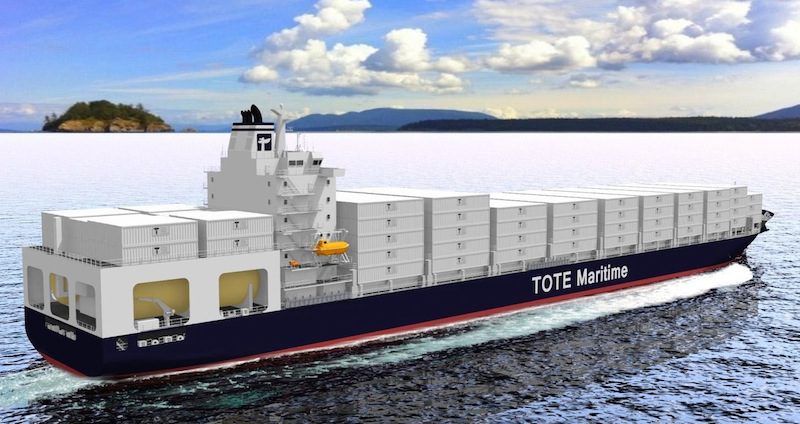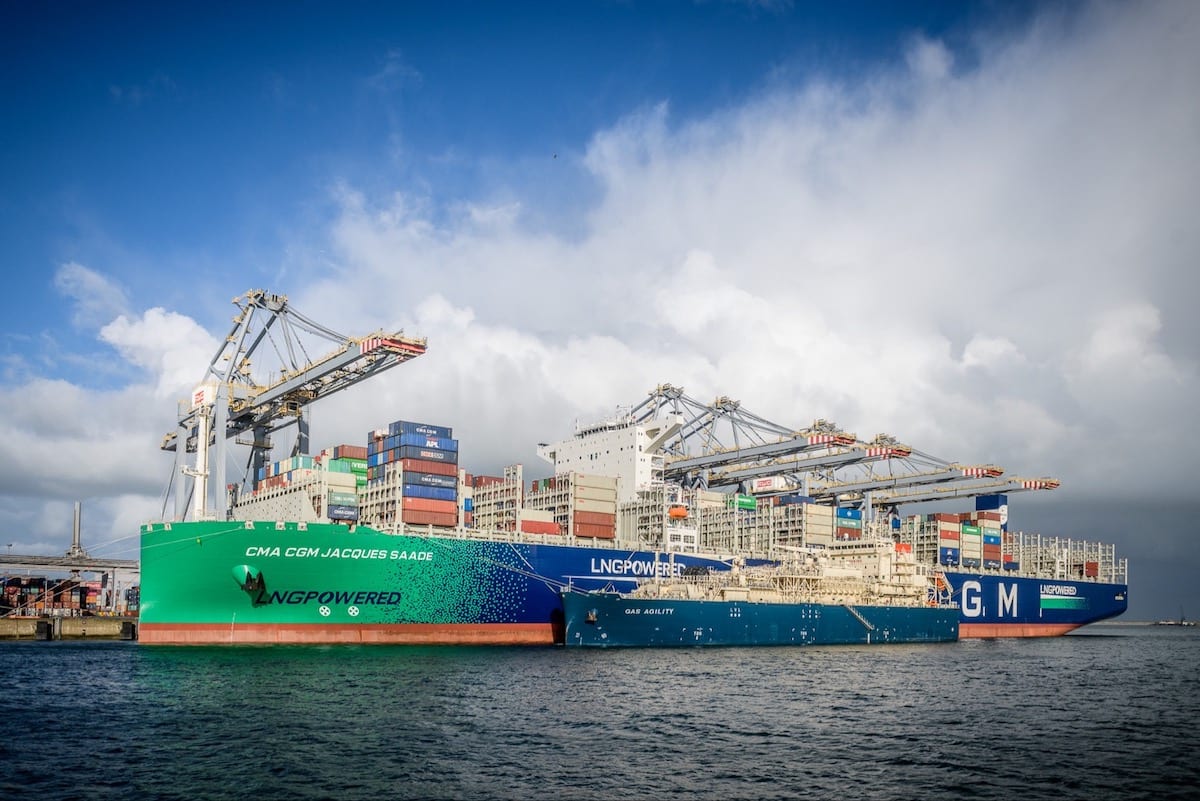TOTE’s new LNG-powered containerships, the world’s first, won the Next Generation Ship Award at Nor-Shipping. The company has ordered up to five of the vessels to operate in the Jones Act market. Image: General Dynamics NASSCO
By Isaac Arnsdorf
Dec. 3 (Bloomberg) — Royal Dutch Shell Plc, General Electric Co. and a company co-founded by T. Boone Pickens are planning investments in natural-gas-powered shipping as record U.S. output spurs the merchant fleet to use a new fuel.
Clean Energy Fuels Corp., which Pickens helped start, will begin construction next year on the country’s first fuel station for cargo ships running on liquefied natural gas in Jacksonville, Florida. Shell said in March it’s planning LNG plants for the Great Lakes and Gulf Coast. GE, evaluating five locations, says the U.S. will need 50 to 100 small-scale plants for ships, trains, mining and trucks by 2025, each costing $50 million to $150 million.
“We truly believe the age of gas is here,” said Mike Hosford, GE’s general manager for unconventional resources, based in Houston. “The industry needs bigger players to step in and start helping to build out the infrastructure.”
SEE ALSO: US Carriers Lean Towards LNG as Marine Fuel of the Future
While the maritime industry still relies on oil-based products for almost all its fuel, tighter emissions rules and abundant natural gas are convincing ship owners to switch. The global fleet of 42 LNG-powered ships will almost triple by next year and increase 42-fold to almost 1,800 vessels by 2020, according to DNV GL, the largest company certifying the merchant fleet for safety.
Norwegian Ferry
Natural gas output in the U.S., the world’s largest producer, rose to 2.198 trillion cubic feet in August, the highest since at least 1973, according to the latest Energy Department data. Marketed production will expand 1.1 percent to 71.03 billion cubic feet a day in 2014, the department estimates.
The first LNG-fueled ship, a Norwegian ferry built in 2000, is one of 42 in operation worldwide, out of about 60,000 merchant vessels, according to DNV GL. Most are small ferries and vessels that shuttle supplies to offshore oil platforms. Tankers hauling LNG in world trade have long used it for fuel through a process known as boil-off.
Thirty-seven new LNG-fueled ships and two conversions are on order, scheduled for delivery in the next three years. By 2020, 1,068 new vessels will be built and 600 to 700 will be converted to run on the fuel, DNV GL says.
The biggest vessels ordered so far are two container ships for delivery in 2015 and 2016 for TOTE Inc., which runs services between the U.S. and Puerto Rico and Alaska. The design for the LNG-powered vessels won the Next Generation Ship Award in June at the industry’s biggest conference in Oslo. Anthony Chiarello, TOTE’s president and chief executive officer, keeps the mermaid- shaped trophy in his Princeton, New Jersey, office.
More Customers
“Within the next five to 10 years, LNG will become the main fuel source for all marine transportation,” said Chiarello, who says he gets at least half a dozen calls a week from other owners asking about the fuel. “It’s going to catch on. When those ships are actually plying the seas and people are then able to calculate the emissions impact and the possible cost savings, they can do all that math and say, ‘This is really a good decision.’”
Some ship owners are waiting for more harbors to add equipment, and gas providers want to see more vessels that can be customers, according to MAN Diesel & Turbo SE, the largest maker of ship engines. Depending on infrastructure, prices and environmental regulations, there could be as many as 2,000 LNG- powered vessels consuming 15 million metric tons by 2020, the Augsburg, Germany-based company estimates.
That would be equal to about 8 percent of current ship consumption of heavy fuel oil known as bunker. Global bunker demand will rise 2.1 percent to 193 million tons in 2014, according to JBC Energy GmbH, a Vienna-based research company.
Emissions Rules
Ship owners started switching to lower-sulfur diesel from bunker in northwest Europe and North America because of national and international anti-pollution rules phased in since 2005. LNG cuts sulfur emissions by 90 percent to 95 percent and also releases less carbon dioxide and nitrogen oxide, according to DNV GL. Alternatives include burning low-sulfur diesel or installing equipment called scrubbers that clean exhaust.
Rising demand could drive fuel costs higher. While U.S. natural gas futures plunged 75 percent to $3.988 per million British thermal units from the record reached in 2005, prices will average $4 in 2015 and $4.25 in the longer term, Morgan Stanley estimates.
LNG ship fuel would cost about $800 a ton in the U.S., $1,000 a ton in Europe and $1,200 in Asia, according to estimates by New York-based shipbroker Poten & Partners Inc. That compares with global prices of $1,300 for an equivalent amount of diesel and $950 for fuel oil with scrubbers.
Dual-Fuel Engines
Matson Navigation Co. ordered two container ships with dual-fuel engines able to use LNG for its West-Coast-to-Hawaii service for $418 million, scheduled for delivery in 2018 from Aker Philadelphia Shipyard Inc. Crowley Holdings Inc., a Jacksonville-based shipping company, ordered two LNG-powered ships to carry containers and vehicles for delivery in 2017 from VT Halter Marine Inc., of Pascagoula, Mississippi.
SEACOR Holdings Inc. ordered two 610-foot (186-meter) tankers at the General Dynamics NASSCO yard in San Diego in September that are designed for eventual conversion to LNG. American Petroleum Tankers Parent LLC, majority-owned by Blackstone Group LP funds, ordered four ships with the same design in May. They are scheduled for 2015 and 2016.
“At some point LNG is going to be a viable marine fuel,” said Rob Kurz, the chief executive officer of American Petroleum Tankers in Plymouth Meeting, Pennsylvania. “The infrastructure is coming, but nobody knows precisely when it will be built out.”
Jacksonville Plant
While the U.S. already has about 60 small-scale liquefaction plants producing about 4.47 million gallons a day used as transportation fuel and to generate electricity, none of them are close enough to water for ships to use, according to Newport Beach, California-based Clean Energy. GE and Ferus Natural Gas Fuels, a closely-held Calgary-based supplier, are partners on the Jacksonville plant through a consortium called Eagle LNG Partners. The facility will supply trucks and ships with as much as 300,000 gallons a day by 2016, according to Clean Energy.
There are also plans for facilities to export from the U.S., including Cheniere Energy Inc.’s terminal at Sabine Pass, Louisiana, which will be the first in the continental U.S. when it opens in 2015. The plant will be able to process 9 million tons a year, eventually rising to 27 million, according to the Houston-based company. The Energy Department approved three other projects so far. U.S. export capacity will reach 72 million tons by 2020, according to Morgan Stanley.
‘Huge Potential’
“Our effort in Jacksonville will be stimulus for the industry to recognize that adopting LNG is something that is possible, feasible and near-term,” Greg Roche, vice president for national accounts at Clean Energy, said by telephone in October. “There’s huge potential domestically for using our own natural resources that are cleaner and cheaper for our markets here.”
Within 30 days of touring an LNG-powered carrier under construction in Norway, Shane Guidry, chief executive officer of Harvey Gulf International Marine LLC, ordered two from a U.S. ship yard. The New Orleans-based owner of vessels supporting offshore drilling in the Gulf of Mexico is spending almost $400 million to build a total of six ships and a fueling terminal in Port Fourchon, Louisiana, that he hopes will eventually sell 270,000 gallons a day.
“When I saw what was going on in Norway, I thought, we can do it here in America,” Guidry said. “We all live in a world where we have to think about clean energy.”
Copyright 2013 Bloomberg.
Unlock Exclusive Insights Today!
Join the gCaptain Club for curated content, insider opinions, and vibrant community discussions.

 Join The Club
Join The Club













